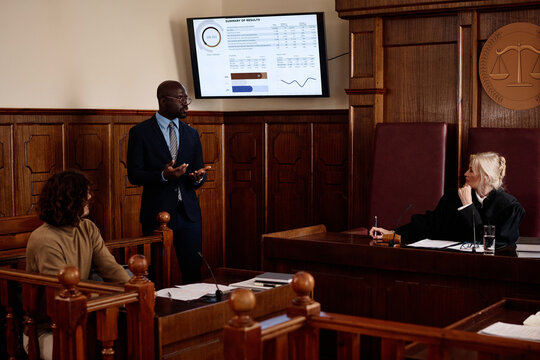The Function of Aesthetic Help in Effective Trial Presentations: An Overview for Lawyer
The Function of Aesthetic Help in Effective Trial Presentations: An Overview for Lawyer
Blog Article
Navigating the Intricacies of Trial Presentations: Tips for Seamless Delivery and Engaging Arguments
In the realm of legal proceedings, the art of trial presentation stands as an important component of success. The intricacies inherent in trial presentations require a delicate balance of method, skill, and skill.

Recognizing Trial Objectives
To properly browse a test, it is crucial to have a clear understanding of the purposes that need to be accomplished. Prior to tipping right into the courtroom, legal teams should specify their objectives and wanted end results. These purposes function as guiding principles throughout the trial, shaping techniques and affecting decision-making procedures.
Recognizing test purposes entails a thorough evaluation of the instance, lawful criteria, and the client's benefits. Trial Presentations. It requires a meticulous evaluation of the facts, identifying key issues, and anticipating potential challenges. By establishing details and quantifiable goals, attorneys can tailor their debates and discussions to align with the desired outcomes
In addition, a clear understanding of trial objectives enables lawful teams to prioritize proof, witnesses, and lawful disagreements efficiently. It enables the growth of a meaningful narrative that resonates with the discretionary, strengthening the total case discussion.

Organizing Evidence Effectively
Having a clear understanding of trial goals lays the foundation for arranging evidence properly in legal process. By lining up the discussion of evidence with the wanted results of the test, legal groups can reinforce their arguments and boost their persuasiveness.
Another crucial element in arranging evidence successfully is establishing a rational circulation. Providing proof in a sequential and meaningful fashion can help develop an engaging narrative that sustains the lawful disagreements being made. In addition, using visual help such as timelines, charts, or charts can even more boost the organization of evidence and help in making clear complex connections or series of occasions.
Furthermore, making sure that all proof offered is admissible and appropriate to the case is vital. Unnecessary or inadmissible evidence can detract from the stamina of the disagreement and possibly damage the reputation of the providing celebration. A meticulous review and option process should be undertaken to include only the most impactful and legally sound proof in the trial presentation.
Crafting Influential Stories
Crafting compelling stories plays a pivotal duty in address providing influential disagreements during lawful proceedings. When creating a narrative for a test presentation, it is necessary to establish a clear story that highlights essential factors and connects them in a systematic manner. By weaving with each other evidence, statement, and legal disagreements right into a persuasive and natural narrative, legal specialists can efficiently support for their clients and boost the likelihood of a positive end result in the courtroom.
Understanding Visual Aids
Efficient usage of visual aids is vital to enhancing the effect and quality of test presentations. Visual help, when made use of strategically, have the power to simplify intricate details, reinforce essential factors, and leave a long-term impression on the discretionary. To understand aesthetic aids in trial presentations, it is vital to make certain that they are clear, concise, and relevant to the disagreements being made.
When integrating aesthetic help, such as graphes, pictures, timelines, or charts, right into a test discussion, it is important to keep them visually appealing yet professional. The visuals ought to match the verbal disagreements, offering a visual representation of the info being talked about without overwhelming the audience with unnecessary details.
Moreover, exercising with the aesthetic help ahead of time is essential to ensure a seamless distribution throughout the test. Acquainting oneself with the material, click here to read shifts, and timings of each visual help can aid keep the circulation of the presentation and prevent technical problems that may arise.
Supplying Impactful Closing Arguments
A compelling closing disagreement serves as the conclusion of a test presentation, enveloping the core narrative and encouraging the judge and court in the direction of a positive choice. Begin by describing the major disagreements that sustain your client's setting, stressing why the evidence provided throughout the test supports your story.
In addition, including psychological appeal can further strengthen your closing disagreement. Eventually, a well-crafted closing disagreement must leave a long-term impact, engaging the court and court to rule in your customer's support.
Verdict
Finally, understanding test discussions entails recognizing purposes, arranging proof, crafting narratives, using visual aids, and delivering impactful closing arguments. By implementing these strategies effectively, lawyers can offer their instance flawlessly and make engaging disagreements in the court. It is essential to navigate the intricacies of test discussions with precision and skill to attain success in lawful procedures.
By aligning the discussion of proof with the preferred outcomes of the test, lawful teams can strengthen their debates and boost their persuasiveness (Trial Presentations). To grasp visual help in trial presentations, it is critical to make certain that they are clear, concise, and relevant to the debates being made
An engaging closing argument offers as the conclusion of a trial discussion, encapsulating the core story and convincing the Going Here judge and court towards a desirable choice. Begin by outlining the major disagreements that support your client's placement, highlighting why the evidence provided throughout the trial sustains your narrative.In final thought, mastering test presentations entails understanding purposes, organizing proof, crafting narratives, using visual aids, and supplying impactful closing disagreements.
Report this page